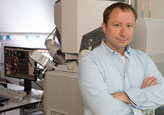What is the best energy for cryoEM?

Christopher Russo
MRC Laboratory of Molecular Biology
Thursday, March 14, 2019 – 12PM
Radiation damage sets the ultimate limit to structure determination using any form of ionizing radiation with sufficient energy to resolve the positions of atoms in a molecule. Electrons, since they interact strongly with biological specimen, induce severe radiation damage, but also provide maximal contrast per unit damage event when compared to X-rays and neutrons. While the amount of information per unit damage for electrons is thought to be approximately constant over the energy range of 10 to 1000 keV, published measurements of radiation damage to biological specimen are not of sufficient accuracy to determine if there is an advantage, in terms of contrast per unit damage, to reducing or increasing the energy of the electron beam. Recently, our measurements of specimen charging and the demonstration of Ewald sphere correction indicate that neither of these present a barrier for reducing the energy of the electron beam from 300 keV, which is the current standard for most commercial high-resolution electron cryomicroscopes. Some theoretical estimates indicate that the ratio of the inelastic to elastic scattering cross sections for carbon may drop by as much as 30% from 300 to 100 keV. With this in mind, we wish to understand both theoretically and experimentally, if there is a potential advantage in terms of radiation damage, in changing the energy of the electron from the conventional 300 keV used for most cryoEM. Here we present our recent progress in measuring how the amount of structural information in electron cryomicrographs of biological specimen scales vs. damage when changing the energy of the incident electron beam. We measure the high energy elastic scattering cross sections of carbon to high accuracy using pure carbon specimens. We compare these data to established theory of electron scattering as well as measurements of damage using the fading of diffraction spots from 2D crystals of paraffin and bacteriorhodopsin (purple membrane). From these measurements, we find that there will likely be an optimum energy for imaging a biological specimen of a given thickness with electrons, assuming that the various technical hurdles to producing efficient detectors at lower energies, can be overcome.

